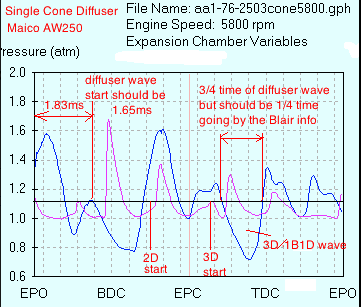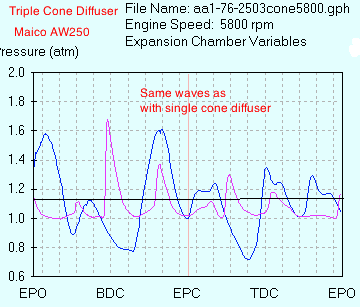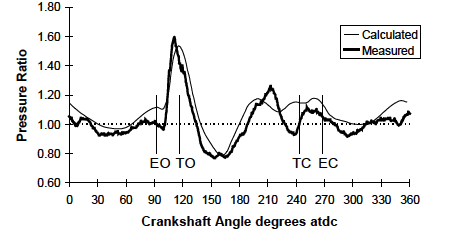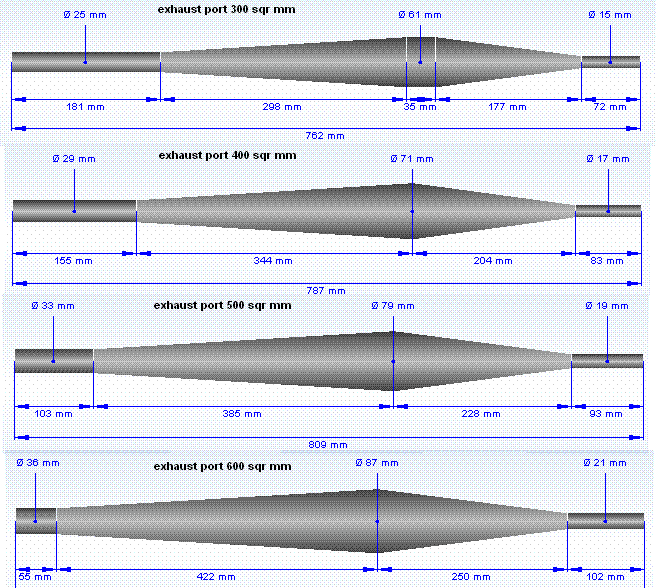|
MOTA for $175 1) Here's another persons comparison between ECcalc and MOTA: Click here. 2) I know a guy in Australia who races a kart with a KTM SX250 engine in it and he has his own dyno and makes his own pipes. He told me he built an optimized pipe designed by the Mota software and it didn't give him good power. 3) A friend of mine put the Maico AW250 engine details into Mota with theoretical pipe details and gave me the same details to put into ECcalc to compare the two results. The Mota waves didn't change from single to triple cone diffuser. At least the diffuser wave should change but it didn't so Mota doesn't use the detailed wave generation method that I use, otherwise the wave peak would be more to the left with a single cone diffuser. ECcalc says the diffuser wave should start at 1.65ms using 564 degrees C mid header temp (@ 5800RPM), and 1.7ms using 514 degrees (which is what ECcalc calculates it would be close to) but Mota shows 1.83ms. Mota shows a high baffle wave peak but the contrary 2nd generation diffuser wave overlaps it which would lower the peak but Mota doesn't show that lowering. Blairs papers show that the secondary diffuser waves are 1/4 the time duration of the primary diffuser wave but Mota makes them 3/4 the time. My conclusion is that Mota is fancy software but they lack the precision that ECcalc has.   Also a person who has Mota says there is no place to enter the exhaust gas temperature which means it provides only a rough estimate which is OK when using a simulator without the secondary waves but when including the secondary waves (as Mota and ECcalc does) it's best to truly know what the temp is. Bimotion for $249 It is an Excel spreadsheet program for designing pipes. They admit on their site that they use Blairs formulas in the book "Design & Simulation of two-stroke engines". Unfortunately not even Blair, way back then (>23 yrs) , was very accurate at simulating the return waves. Here is an example of his simulation from one of his research papers, the one on his dyno. Notice how the calculated wave (thin line) lacks the pressure dip before TC that is caused in this example by the negative pressure 2D and 1B1D secondary waves.  2 Stroke Wizard for $27 I had bought this program before starting on making ECcalc and it just wasn't very good at designing a good pipe. And when my hard disk crashed I asked them to send it to me again to replace the lost program and they wouldn't even reply to my email ! This program only uses Blairs formulas which are childs play compared to properly simulating the return waves and calculating the power depending on them. Crappy free programs Some programs are even based on the formulas proposed by Gordon Jennings from way back in the early 70's. Man they were just beginning to investigate back then. Basically they knew next to nothing. Jennings main shortcomings; 0. He assumes the same temperature and sound wave speed inside all pipes. 1. Because of his temperature error his calculations for the tuned length were off by 3.5" compared to a Maico 440 pipe, and 1.75" compared to a Maico 250 pipe. (both pipe specs along with full engine data, horsepower data, and EGT were given to me for analysis.) 2. He uses formulas to calculate everything but belly length, letting it take up the remaining distance. This is totally wrong because the belly length should be set to allow a slight overlap of the diffuser and baffle waves. That set length is optimally almost always below 4" (100mm). 3. He had no idea whatsoever about the return waves the exhaust pulse causes, their return time or their time duration. His ideology was not based on the reality of what was happening inside the pipe but just on scant trial and error data. 4. He calculates the header length as a multiple of its diameter. It's correct length is that which locates the secondary waves in correct relation to exhaust closing time at top RPM. 5. He calculates the belly diameter as a multiple of the header diameter although the header can be too narrow or too wide. Proper sizing depends on the exhaust pulse pressure. 6. He calculates the stinger diameter as a fraction of the header diameter whereas it should be calculated by the exhaust pulse pressure. 7. He calculates the stinger length as a multiple of its diameter whereas in reality the same back pressure can be had by a fat long stinger as by a skinny short stinger. 8. He recommends not going over a combined baffle angle of 30 degrees (15 from centerline) although many successful pipes use much larger angles. According to physics there is no limit to the angle. It's just that the shorter the baffle, the shorter its return wave. The return wave length should match the RPM, the timing between transfers closing and exhaust closing, and the desired RPM spread of the power band. And its length is dependent on the length of the exhaust pulse. 9. He was calculating for a single coned diffuser which gives weak results compared to a multi-coned diffuser of gradually increasing angles. 10. He calculated for a 2 to 1 ratio of angles between the baffle and diffuser which is too limiting. Any way when you go to a multi-coned diffuser there is no single angle of overwhelming importance to compare the baffle angle to. So in modern pipes there is no ratio formula. Well he was a pioneer 46 years ago but anyone who uses his formulas now is way behind the times. We have progressed so much farther than his formulas and now have computers to simplify the complex process. (But thank you Gordon for helping along pipe research in the early days. RIP) At a certain online pipe calculator I entered specs for an engine reving to 10,000 RPM and only changed the area for the exhaust port to get four different pipes. You can see how the timing is different for each one as evidenced by the different total lengths till the baffle cone. That is a disaster because the needed wave timing to match the ports timing would remain almost the same but they changed it drastically on each pipe, evidenced by changing their lengths. Here's how the program works: It makes the header diameter according to the exhaust port size, then the belly diameter according to the header diameter, then the baffle and diffuser angles (at a 2:1 ratio) according to the desired exhaust temperature which remained the same for all four pipes. Its emphasis was on areas, not timings. All 4 pipes have different tuned lengths (to the start of the baffle wave) and 3 of them didn't even have a belly which is needed to separate the diffuser and baffle waves so that your're not wasting energy by letting then cancel each other out where they cross (since they are of opposite pressure). And it designed only single cone diffusers which are ineffective compared to 3 cone diffusers.  If you want a really good pipe for really good power you shouldn't screw around. I love 2 strokes and I want to contribute to their continued existence and peoples enjoyment of them which is why I offer ECcalc as my contribution to the 2 stroke world. Get it now before I start charging for it what I think it's truly worth. ;-) |